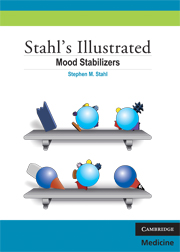Book contents
- Frontmatter
- Preface
- Contents
- CME Information
- Visual Vocabulary Legend
- Objectives
- Chapter 1 Symptoms and Spectrum of Bipolar Disorder
- Chapter 2 From Symptoms to Circuits
- Chapter 3 From Circuits to Mechanisms
- Chapter 4 Lithium and Various Anticonvulsants as Mood Stabilizers for Bipolar Disorder
- Chapter 5 Atypical Antipsychotics as Mood Stabilizers for Bipolar Disorder
- Chapter 6 Building a Treatment Plan
- Summary
- Addendum
- Abbreviations
- Suggested Readings
- Index
- CME: Posttest and Certificate
Chapter 1 - Symptoms and Spectrum of Bipolar Disorder
Published online by Cambridge University Press: 22 October 2021
- Frontmatter
- Preface
- Contents
- CME Information
- Visual Vocabulary Legend
- Objectives
- Chapter 1 Symptoms and Spectrum of Bipolar Disorder
- Chapter 2 From Symptoms to Circuits
- Chapter 3 From Circuits to Mechanisms
- Chapter 4 Lithium and Various Anticonvulsants as Mood Stabilizers for Bipolar Disorder
- Chapter 5 Atypical Antipsychotics as Mood Stabilizers for Bipolar Disorder
- Chapter 6 Building a Treatment Plan
- Summary
- Addendum
- Abbreviations
- Suggested Readings
- Index
- CME: Posttest and Certificate
Summary
This chapter introduces the symptoms of depression and mania as well as some symptoms commonly associated with bipolar disorder. Patients with bipolar disorder often present with symptoms that are nearly identical to those of patients with unipolar depression, and recognizing differences between these disorders can therefore be difficult. Patients with bipolar disorder often seek help during periods of depression and report manic symptoms with less frequency, further complicating diagnosis. Although bipolar disorder is increasingly diagnosed, it is still quite often overlooked or misdiagnosed as unipolar depression, anxiety, or other psychiatric illnesses. A spectrum of disorders might be a more realistic way to conceptualize bipolar illness, as patients present with a variety of mood cycles not sufficiently characterized by the traditional distinctions of Bipolar I, Bipolar II, and cyclothymic disorder. To account for this individuality, a symptom-based treatment algorithm can help guide therapeutic decisions. The premise of this algorithm is to first attain a full understanding of each patient's clinical symptoms and then to make treatment decisions based on thorough knowledge of the neurobiological and pharmacological interactions involved in each treatment choice. Chapter 1 introduces the first step of this algorithm: identifying diagnostic and associated symptoms.
This chart also illustrates definitions of disease states: hypomania is a less severe, shorter-lasting form of mania (see Fig. 1.5), and dysthymia is a less severe, longer-lasting form of depression (see Fig. 1.4 and Fig 1.13).
- Type
- Chapter
- Information
- Stahl's Illustrated Mood Stabilizers , pp. 1 - 16Publisher: Cambridge University PressPrint publication year: 2009

